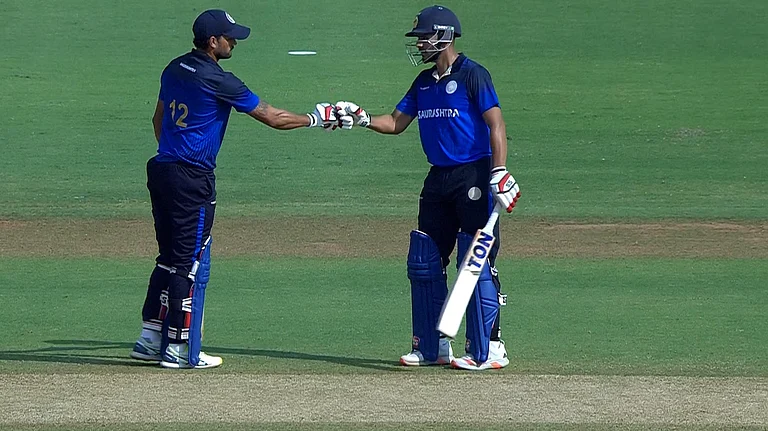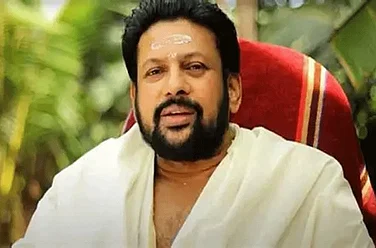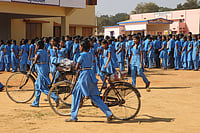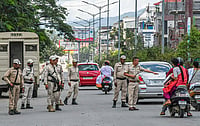The ongoing armed conflict in Manipur has displaced more than 70,000 people. As per government data, more than 14,545 displaced students in five districts worst affected by the ethnic clashes—Imphal West, Imphal East, Bishnupur, Churachandpur and Kangpokpi—have been sheltered in relief camps. More than 3,000 of them are below five years of age.
News reports say that schools in the hill districts of Manipur have been closed for more than three months now. Children living in the relief camps have been forced out of school. Around 100 schools across the state have been turned into relief camps. As per the state government’s submission to the Supreme Court, schools have not been able to function in the three hill districts of Churachandpur, Kangpokpi and Tengnoupal.
Many schools across the valley have been vandalised. Imphal’s St Peter School and Children’s Treasure High School of Torbung village were burnt down by an armed mob. It has been reported that many children are being used as child soldiers in this conflict. Several teenagers have been undergoing arms training after being forced out of school. News agencies say that there is a dire food shortage in Thonju Kendra Relief Camp in Imphal and Psycot Relief Camp in Churachandpur. Medicines are also in short supply for the children living there. Lactating mothers in relief camps lack proper nutrition owing to which they are unable to provide the requisite nourishment to their infants.
The prolonged closure of schools, lack of proper nutrition, burning down of school buildings and usage of children as child soldiers are grave violations of child rights during armed conflicts as per the UN. On 27 June 2023, the UN released a report titled ‘Children and Armed Conflict’, which accounted for the grave violations of child rights in armed conflict across the world in 2022. India’s name was removed from the report after 12 years. Till last year, India was included in it based on allegations that some separatist militant groups operating in Jammu and Kashmir were recruiting children. It was also then alleged that Indian security forces in Kashmir detained children, accusing them of being associated with militant groups. It is worth noting that Bastar and the Northeast region are also heavily affected by armed conflict and the Armed Forces Special Powers Act (AFSPA) is in effect in many parts of the Northeast. Operation Green Hunt was launched in Bastar by heavily deploying central security forces to counter secessionist and extremist groups there. The UN report had not mentioned child rights violations in these regions even though multiple such violations by all the parties of war have been reported from there.

Children trapped in armed conflicts are witnesses to brutalities and assaults on their close ones, which can lead to severe post-traumatic stress disorder (PTSD) in them. As per researchers, prolonged PTSD induced by armed conflict can hinder their learning capability during the formal schooling years and hence push them down the ladder of socio-economic prosperity in the future.
In 2017, Save the Children had conducted research to map PTSD in armed conflict-affected children in the refugee camps of Syria. It interviewed a group of children, adolescents, parents, caregivers, psychological workers, teachers and psychologists. It was concluded that 71 per cent of children in Syrian refugee camps were suffering from armed conflict-induced PTSD.
A news report quotes a mother in a relief camp at Imphal saying that her children are traumatised on hearing gun shots. They are further traumatised if someone threatens that the Kukis will come to kill them. The mother has heard her elder daughter say that she will pick up a gun to kill the Kukis, and also burn Kuki homes like they burnt their family home. A news portal reported that younger children in the camps, some of whom have witnessed extensive violence, are filled with anger and helplessness. They live in fear that the violent mob will come to their camps dressed as police commandos and hurl bombs at them. Such fears ultimately might lead to long-term PTSD in these children which will hinder their learning capabilities the formal schooling years. Multiple researchers have studied the impact of persistent and chronic fear and trauma disorder on the learning and development capabilities of children. There is enough scientific evidence to prove that PTSD or persistent fear and anxiety have detrimental impacts on a child’s capability to learn and develop. A paper published by the Centre on the Developing Child, Harvard University, argues that early exposure of children to circumstances that produce persistent fear can have prolonged (sometimes extended to lifelong) consequences by hindering the development architecture of their brains. Children’s ability to learn, solve problems, and relate concepts to life can be deeply compromised.
Children experience fears and can differentiate fear from other emotions when they are between 6 to 12 months of age. While some forms of fear are a normal part of the developmental process, such childhood fears are different from the ones induced by a traumatic event like witnessing violence on a close one or suffering abuse during an armed conflict. Normally, childhood fears dissipate by the age of 7 or 8. This is because children develop their social and cognitive senses by this age in order to differentiate between the causes of such childhood fears as real or imaginary. They also develop a better understanding of their environment and hence, are hardly threatened by instances around them (which previously used to frighten them).
Circumstances that induce fear and trauma during armed conflict are interpreted by children as real and they can anticipate the possibility of those circumstances being created again. This prolongs the PTSD created by such circumstances if induced in children. Young children who perceive the world as a threatening place have a wide range of multiple conditions that can trigger anxious behaviours that impair their ability to learn and interact socially with others. Children living in armed conflict zones are more prone to such PTSD-inducing circumstances than those living in other areas. The UN doesn’t consider armed conflict-induced PTSD a grave child rights violation during conflict. But if unaddressed, this will further push generations of armed conflict-affected children into a dark pit of illiteracy, poor socio-economic growth and poverty like it has been doing in conflict-affected areas like Bastar.
The issue of protection of child rights during armed conflicts needs to be acknowledged by the Indian government immediately. This can be addressed on two levels. First, the parties to the armed conflict of a specific geography need to be brought on the same page by national and international CSOs to protect child rights. Peace talks could be initiated between the parties. These can have multiple layers, all of which need to be explored. Parties to the conflict should develop a common consensus of not using school buildings for war-related activities, protecting children during conflict, not hindering their access to essential commodities, refraining from using child soldiers, and not detaining or jailing children. The parties to the war should stick to the UN’s and Geneva Convention guidelines of armed conflict.
One of the promising instances in this respect is the reopened schools of Bastar region. Government schools of Sukma and Bijapur districts were demolished by Maoists at the onset of the 2000s as the security forces used to occupy them. Thousands of children were forced out of school at the time. In 2018, the local villagers convinced the parties to the war—the Sukma district administration and the Maoists—to allow the reopening of 93 schools in highly sensitive areas of Konta Block in Sukma. These schools were set up in thatched huts and they paved the way for Primary Healthcare Centres in those regions. In 2021, following Sukma’s footsteps, 110 closed and demolished schools were reopened in Bijapur district. This is an exemplary example, but other child rights violations like usage of child soldiers by Maoists are still rampant in the region.
Secondly, armed conflict-induced PTSD needs to be addressed by the Indian government. It should undertake initiatives to map PTSD in children living in conflict-prone areas. PTSD can be treated by implementing specific school-based pedagogies designed in consultation with practising physiatrists and education departments. Communities of mothers and teachers can also be involved in designing and implement specific socio-emotional learning-based pedagogies to ensure armed conflict-affected children sustainable and institutional support to overcome the trauma that they have encountered.
(Views expressed are personal)
(This appeared in the print as 'Childhood Disrupted')
Prasun Goswami is a Campaigner for Disarmed schools and safe childhoods


























